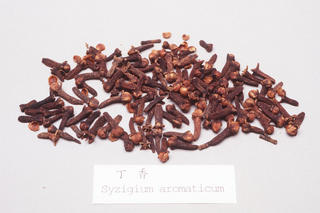Eugenis caryophyllata
Contents
Nomenclature
Other Names:
Historical Use of Eugenis caryophyllata
Eugenis caryophyllata in Traditional Chinese Medicine
Background
Gongdingxiang ¹«¶¡Ïã
Mudingxiang ĸ¶¡Ïã
Chinese Name (pinyin): Dingxiang
Chinese Name :
Common Name :Cloves
Specific Name : Flos caryophylli
Scientific Name:
Collection : The drug is collected when it turns from green to brick-red and dried in the sun.
Description : Pestle shaped, 1 - 2cm long, corolla glubular, 0.3 - 0.5cm in diameter, petals 4, imbricated, dark brown to brownish-yellow, enclosing stamens and style. After rubbing into pieces, numerous yellow and granulart anthers visible. Calyx tube cylindrical, slightly flattened, sometimes slightly curved, 0.7 - 1.4cm long, 0.3 - 0.6cm in diameter, reddish brown or dark brown, sepals 4, triangular, occuring at the upper part, separating in crusiform. Texture hard, oily, odour strongly aromatic, taste pungent and numb.
Identification : 1.Transverse section of the middle calyx tube, epidermal cells 1 row with relatively thick cuticle. Oil cavities 2-3 rows, longitudinally elongated-elliptical, 150-200µm long, scattered in the outer part of cortex. 20-50 smallbicollateral vascular bundles underneath arranged in an interuptedd ring and surounded by few pericyclic fibres with thickened and lignified walls. Aerenchyma consisting of several layers fo parenchymatous cells, occurring in the inner part with large intercellular space. Numerous small vascular bundles scattered in the stele parenchyma. Parenchymatous cells consisting of numerous fine clusters of calcium oxalate. Powder: dark reddish brown, fibres spindle shaped apex obtusely rounded with thickened walls. Pollen grains numerous, triangular in polar view and two convex lense shaped in equatorial surface view with 3 furrows. Clusters of calcium oxalate numerous, 4-26µm in diameter occurring in relatively small parenchymatous cells. Oil cavities frequently broken, dividing lines of secretory cells indistinct containing yellow oil.2.To 0.5g of the powder add 5ml of ether, shake for several minutes, filter, the filtrate is used as the test solution. Dissolve eugenol CRS in ether to produce a solution containing 16µl per ml as the reference solution. Carry out the method for thin layer chromatography (Appendix Vl B) using silica G as the coating substance and petroleum ether (60-90ºC)-ethyl acetate (9:1) as the mobile phase. Apply 5µl of each of the two solutions to the plate. After developing and removal of the plate, dry it in the air, spraqy with 5% solution of vanillin in sulfuric acid and heat at 105ºC. The spot in the chromatogram obtained with the test solution correspond in position and color to the spot obtained with the reference solution.Foreign matter: not less than 4% (Appendix lX A)Water: carry out the method of determination of water (Appendix lX H, method 2) not more than 12.0%Assay: carry out the method of determination of volatile oil (Appendix X D) on adding 2ml of xylene. It contains not less than 16.0% of volatile oil (ml/g).
Processing : Eliminate foreign matter and sift the dust. Pound to pieces before use.
Action : To warm the spleen and stomach, to regulate the adverse flow of the stomach qi, and to restore kidney yang.
Indication : Hiccup, vomiting, anorexia, diarrhea, epigastral and abdominal pain with cold sensation in deficiency-cold syndromes of the spleen and stomach, impotence due to deficiency of the kidney yang
Precautions :
Dosage : 1 to 3 g.
Storage : Preserve in a cool and dry place.
Synonymns for Eugenis caryophyllata
Patent Medicines and Medicines with Multiple Ingredients that include Eugenis caryophyllata
Pharmaceutical Information
Chemical Constituents
Evidence or the Use of Eugenis caryophyllata in the Treatment of Epilepesy
Basic Science
Animal Studies
Cohort, Case-Control and Non-Randomized Trials
Randomized Controlled Trials
Meta-Analysis
1st Five Results: pubmed search
